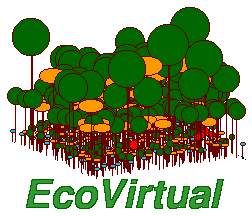en:ecovirt:roteiro:math:roteiros
Differences
This shows you the differences between two versions of the page.
| Both sides previous revision Previous revision Next revision | Previous revision | ||
|
en:ecovirt:roteiro:math:roteiros [2022/09/15 15:20] adalardo |
en:ecovirt:roteiro:math:roteiros [2022/09/15 15:28] (current) adalardo [Integral and Differential Calculus] |
||
|---|---|---|---|
| Line 19: | Line 19: | ||
| Here you find that the exponential function is the limit of a discrete growth at a constant rate, when we make the time intervals very small. For this, we will go through the concept of derivatives and the notion of limit of a function. | Here you find that the exponential function is the limit of a discrete growth at a constant rate, when we make the time intervals very small. For this, we will go through the concept of derivatives and the notion of limit of a function. | ||
| + | * [[en:ecovirt:roteiro:math:exponencial|Growth rates, derivatives and exponential function]] | ||
| - | * [[en:ecovirt:tutorial:math:exponential|Growth rates, derivatives and exponential function]] | ||
| + | |||
| <-- | <-- | ||
| Line 30: | Line 31: | ||
| Know the integral, inverse derivative operation. Learn the difference between definite and indefinite integrals. | Know the integral, inverse derivative operation. Learn the difference between definite and indefinite integrals. | ||
| - | * [[en:ecovirt:script:math:integralr|Antiderivatives and definite integral]] | + | * [[en:ecovirt:roteiro:math:integralr|Antiderivatives and definite integral]] |
| <-- | <-- | ||
| Line 40: | Line 41: | ||
| A differential equation is a relationship between the derivative of a function and some other mathematical function. Understand how these equations can be proposed and solved. | A differential equation is a relationship between the derivative of a function and some other mathematical function. Understand how these equations can be proposed and solved. | ||
| - | * [[en:ecovirt:script:math:eq_difr|Introduction to differential equations]] | + | * [[en:ecovirt:roteiro:math:eq_difr|Introduction to differential equations]] |
| <-- | <-- | ||
| Line 49: | Line 50: | ||
| Tutorials to solve differential equations with the help of computer programs. Computational numerical integration is the basic tool for mathematical modeling in biology. | Tutorials to solve differential equations with the help of computer programs. Computational numerical integration is the basic tool for mathematical modeling in biology. | ||
| - | * [[en:ecovirt:script:math:numeric_int_ipython|Numerical integration of differential equations]] | + | * [[en:ecovirt:roteiro:math:numeric_int_ipython|Numerical integration of differential equations]] |
| <-- | <-- | ||
| Line 58: | Line 59: | ||
| Does an ecological dynamic tend to a state of equilibrium? Does this equilibrium resist disturbances? Here's how to answer these questions with the help of calculus. | Does an ecological dynamic tend to a state of equilibrium? Does this equilibrium resist disturbances? Here's how to answer these questions with the help of calculus. | ||
| - | * [[en:ecovirt:script:math:stabilitysage|Stability analysis]] | + | * [[en:ecovirt:roteiro:math:stabilitysage|Stability analysis]] |
| <-- | <-- | ||
| Line 77: | Line 78: | ||
| ==== Random walks ==== | ==== Random walks ==== | ||
| - | {{:ecovirt:script:neutr1.jpg?150 |}} | + | {{:ecovirt:roteiro:neutr1.jpg?150 |}} |
| The [[http://en.wikipedia.org/wiki/Markov_chain|Markov Chains]] are used to describe ecological dynamics. They are models of stochastic processes in which time is discrete, and at each interval the system can change state, with a certain probability. The probabilities of changing from one state to another depend only on the present state ((Therefore, they can be expressed in transition matrices from time t to time t+1, as in [[en:ecovirt:roteiro:pop_str:pstr_mtexcel|]] | The [[http://en.wikipedia.org/wiki/Markov_chain|Markov Chains]] are used to describe ecological dynamics. They are models of stochastic processes in which time is discrete, and at each interval the system can change state, with a certain probability. The probabilities of changing from one state to another depend only on the present state ((Therefore, they can be expressed in transition matrices from time t to time t+1, as in [[en:ecovirt:roteiro:pop_str:pstr_mtexcel|]] | ||
| Line 87: | Line 88: | ||
| See why a walking drunk will do poorly, even if on average he walks in a straight line. | See why a walking drunk will do poorly, even if on average he walks in a straight line. | ||
| - | * [[:ecovirt:roteiro:math:drunkRcmdr|Random Walk Tutorial]] | + | * [[:ecovirt:roteiro:math:bebadoRcmdr|Random Walk Tutorial]] |
| <-- | <-- | ||
en/ecovirt/roteiro/math/roteiros.1663266032.txt.gz · Last modified: 2022/09/15 15:20 by adalardo
Except where otherwise noted, content on this wiki is licensed under the following license: CC Attribution-Noncommercial-Share Alike 4.0 International

